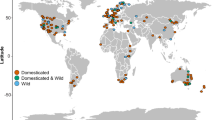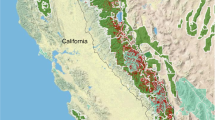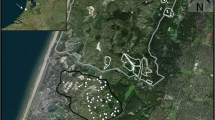Abstract
Wild burros (Equus asinus), protected by the 1971 Wild Free-Roaming Horse and Burro Act on some federal lands but exotic animals many ecologists and resource mangers view as damaging to native ecosystems, represent one of the most contentious environmental management problems in American Southwest arid lands. This review synthesizes the scattered literature about burro effects on plant communities of the Mojave Desert, a center of burro management contentions. I classified 24 documents meeting selection criteria for this review into five categories of research: (i) diet analyses directly determining which plant species burros consume, (ii) utilization studies of individual species, (iii) control-impact comparisons, (iv) exclosure studies, and (v) forage analyses examining chemical characteristics of forage plants. Ten diet studies recorded 175 total species that burros consumed. However, these studies and two exclosure studies suggested that burros preferentially eat graminoid and forb groups over shrubs. One study in Death Valley National Park, for example, found that Achnatherum hymenoides (Indian ricegrass) was 11 times more abundant in burro diets than expected based on its availability. Utilization studies revealed that burros also exhibit preferences within the shrub group. Eighty-three percent of reviewed documents were produced in a 12-year period, from 1972 to 1983, with the most recent document produced in 1988. Because burros remain abundant on many federal lands and grazing may interact with other management concerns (e.g., desert wildfires fueled by exotic grasses), rejuvenating grazing research to better understand both past and present burro effects could help guide revegetation and grazing management scenarios.




Similar content being viewed by others
References
Beever EA, Brussard PF (2000) Examining ecological consequences of feral horse grazing using exclosures. Western North American Naturalist 60:236–254
Bennett PS, Phillips AM, Ruffner GA, Carothers SW, Johnson RR (1981) Effects of burro foraging on four types of Grand Canyon vegetation. In: Proceedings of the Second Conference on Scientific Research in the National Parks. U.S. Department of the Interior, National Park Service, Washington, DC, pp 319–337
Bowers JE (1997) Demographic patterns of Ferocactus cylindraceus in relation to substrate age and grazing history. Plant Ecology 133:37–48
Bradford DF, Jaeger JR, Jennings RD (2004) Population status of a decimated amphibian, the relict leopard frog (Rana onca). Southwestern Naturalist 49:218–228
Brooks ML (1999) Alien annual grasses and fire in the Mojave Desert. Madroño 46:13–19
Browning B (1960) Preliminary report of the food habits of the wild burro in the Death Valley National Monument. Desert Bighorn Council Transactions 18:88–90
Carothers SW, Stitt ME, Johnson RR (1976) Feral asses on public lands: an analysis of biotic impact, legal considerations and management alternatives. North American Wildlife and Natural Resources Conference Transactions 41:396–406
Dixon JS, Sumner EL (1939) A survey of desert bighorn in Death Valley National Monument, summer 1938. California Fish and Game 25:72–95
Douglas CL, Hiatt HD (1987) Food habits of feral burros in Death Valley, California. No. 006/46. Cooperative National Park Resources Studies Unit, University of Nevada Las Vegas
Douglas CL, Hurst TL (1993) Review and annotated bibliography of feral burro literature. No. 044/02. Cooperative National Park Resources Studies Unit, University of Nevada Las Vegas
Douglas CL, Leslie DM (1996) Feral animals on rangelands. In: Krausman PR (ed) Rangeland wildlife. Society for Range Management, Denver CO, pp 281–292
Douglas CL, Norment C (1977) Habitat damage by feral burros in Death Valley. Desert Bighorn Council Transactions 21:23–25
Douglas CL, Norment C (1979) Ecological studies of feral burros in Death Valley. National Park Service Transactions and Proceedings Series 5:373–383
Farrell JE (1973) Behavioral patterns of feral burros as influenced by seasonal changes in western Arizona. M.Sc. thesis, Arizona State University, Tempe
Fisher JC (1974) Plant transects from inside and outside two burro exclosures in Death Valley National Monument. Unpublished report on file at Death Valley National Monument, Death Valley, CA
Fisher JC (1975) Acamptopappus-Grayia plant community of the Panamint Mountains of Death Valley National Monument. Unpublished report on file at Death Valley National Monument, Death Valley, CA
Ginnett TF (1982) Comparative feeding ecology of feral burros and desert bighorn sheep in Death Valley National Monument. M.Sc. thesis, University of Nevada Las Vegas
Ginnett TF, Douglas CL (1982) Food habits of feral burros and desert bighorn sheep in Death Valley National Monument. Desert Bighorn Council Transactions 26:81–87
Gurevitch J, Curtis PS, Jones MH (2001) Meta-analysis in ecology. Advances in Ecological Research 32:199–247
Hanley TA (1976) Carrying capacity relationships of feral burro (Equus asinus) habitat in a Sonoran Desert ecosystem. M.Sc. thesis, Arizona State University, Tempe
Hanley TA, Brady WW (1977a) Seasonal fluctuations in nutrient content of feral burro forages, lower Colorado River valley, Arizona. Journal of Range Management 30:370–373
Hanley TA, Brady WW (1977b) Feral burro impact on a Sonoran Desert range. Journal of Range Management 30:374–377
Hansen RM, Martin PS (1973) Ungulate diets in the lower Grand Canyon. Journal of Range Management 26:380–381
Hunter RB (1991) Bromus invasions on the Nevada Test Site: present status of B. rubens and B. tectorum with notes on their relationship to disturbance and altitude. Great Basin Naturalist 51:176–182
Hunter RB, Wallace A, Romney EM (1980) Fencing enhances shrub survival and growth for Mojave Desert revegetation. Great Basin Naturalist Memoirs 4:212–215
Johnson RA, Carothers SW, McGill TJ (1987) Demography of feral burros in the Mohave Desert. Journal of Wildlife Management 51:916–920
Jordan JW, Ruffner GA, Carothers SW, Phillips AM (1979) Summer diets of feral burros (Equus asinus) in Grand Canyon National Park, Arizona. In: Denniston RH (ed) Symposium on the ecology and behavior of wild and feral equids. University of Wyoming, Laramie, pp 15–22
Leslie DM, Douglas CL (1979) Desert bighorn sheep of the River Mountains, Nevada. Wildlife Monographs 66
Longshore KM, Douglas CL (1988) Vegetational recovery following burro removal in Death Valley National Monument. No. 035/04. Cooperative National Park Resources Studies Unit, University of Nevada Las Vegas
Lovich JE, Bainbridge D (1999) Anthropogenic degradation of the southern California desert ecosystem and prospects for natural recovery and restoration. Environmental Management 24:309–326
McKnight TL (1957) Feral burros in the American Southwest. Journal of Geography 56:315–322
McKnight TL (1958) The feral burro in the United States: distribution and problems. Journal of Wildlife Management 22:163–178
McMichael TJ (1964a) Studies of relationships between desert bighorn and feral burro in the Black Mountains of northwestern Arizona. M.Sc. thesis, University of Arizona, Tucson
McMichael TJ (1964b) Relationships between desert bighorn and feral burro in the Black Mountains of northwest Arizona. Desert Bighorn Council Transactions 8:29–35
Milchunas DG (2006) Responses of plant communities to grazing in the southwestern United States. General Technical Report RMRS-GTR–169. U.S. Department of Agriculture, Forest Service, Rocky Mountain Research Station, Fort Collins, CO
Norment C, Douglas CL (1977) Ecological studies of feral burros in Death Valley. No. 17. Cooperative National Park Resources Studies Unit, University of Nevada Las Vegas
O’Farrell MJ (1978) An assessment of impact of feral burros on natural ecosystems of the Lake Mead National Recreation Area, Arizona-Nevada. No. 013/05. Cooperative National Park Resources Studies Unit, University of Nevada Las Vegas
Potter RL, Hansen RM (1979) Feral burro food habits and habitat relations, Grand Canyon National Park, Arizona. In: Denniston RH (ed) Symposium on the Ecology and Behavior of Wild and Feral Equids. University of Wyoming, Laramie, pp 143–153
Rowlands P, Johnson H, Ritter E, Endo A (1982) The Mojave Desert. In: Bender GL (ed) Reference handbook on the deserts of North America. Greenwood Press, Westport, CT, pp 103–162
Ruffner GA, Carothers SW (1982) Age structure, condition and reproduction of two Equus asinus (Equidae) populations from Grand Canyon National Park, Arizona. Southwestern Naturalist 27:403–411
Rundel PW, Gibson AC (1996) Ecological communities and processes in a Mojave Desert ecosystem: Rock Valley, Nevada. Cambridge University Press, New York
Sanchez PG (1974) Impact of feral burros on the Death Valley ecosystem. In: Yoakum J, Pontrelli M, Ferrel CM, Shapovalov L, White M, Tueller P, Graham H, Lockard D (eds) California-Nevada Wildlife 1974 Transactions, pp 21–34
Seegmiller RF, Ohmart RD (1981) Ecological relationships of feral burros and desert bighorn sheep. Wildlife Monographs 78
Smith AE (1969) Burro problems in the Southwest. Desert Bighorn Council Transactions 13:91–97
Stohlgren TJ, Schell LD, Vanden Heuvel B (1999) How grazing and soil quality affect native and exotic plant diversity in Rocky Mountain grasslands. Ecological Applications 9:45–64
Sumner L (1959) Effects of wild burros on bighorn in Death Valley National Monument. Desert Bighorn Council Transactions 3:4–8
Thomas HS (1979) The wild horse controversy. A.S. Barnes and Co., Cranbury, NJ
Tiller BL (1997) Feral burro populations: distribution and damage assessment. Report prepared for the Department of Public Works, U.S. Army, Fort Irwin, CA
USBLM (U.S. Bureau of Land Management) (2006) Spring Mountains Herd Management Complex—final population management plan and environmental assessment NV-052–2007-50. Las Vegas Field Office, Las Vegas, NV
USNPS (U.S. National Park Service) (1994) Draft environmental impact statement: burro management. Lake Mead National Recreation Area, Boulder City, NV
USNRCS (U.S. Natural Resources Conservation Service) (2007) The PLANTS database (http://www.plants.usda.gov). National Plant Data Center, Baton Rouge, LA
Valone TJ, Meyer M, Brown JH, Chew RM (2002) Timescale of perennial grass recovery in desertified arid grasslands following livestock removal. Conservation Biology 16:995–1002
Wagner FH (1983) Status of wild horse and burro management on public rangelands. North American Wildlife and Natural Resources Conference Transactions 48:116–133
Walker MT (1978) Ecological similarities between feral burros and desert bighorn sheep, Black Mountains, northwestern Arizona. M.Sc. thesis, Arizona State University, Tempe
Watkins KA (1976) Chemical composition and in vitro digestibility of feral burro forage. M.Sc. thesis, Arizona State University, Tempe
Weaver RA (1973) Burro versus bighorn. Desert Bighorn Council Transactions 17:90–97
Welles RE, Welles FB (1961) The bighorn of Death Valley. Fauna of the National Parks of the United States No. 6. U.S. Government Printing Office, Washington, DC
White LD (1980) A study of feral burros in Butte Valley, Death Valley National Monument. M.Sc. thesis, University of Nevada Las Vegas, Las Vegas
Woodward SL, Ohmart RD (1976) Habitat use and fecal analysis of feral burros, Chemehuevi Mountains, California. Journal of Range Management 29:482–485
Yancey MJ, Douglas CL (1983) Burro-small vertebrate interactions in Death Valley National Monument, California. Desert Bighorn Council Transactions 23:17–24
Zarn M, Heller T, Collins K (1977a) Wild, free-roaming burros—status of present knowledge. Technical Note 296. U.S. Department of the Interior, Bureau of Land Management, and U.S. Department of Agriculture, Forest Service. U.S. Government Printing Office, Washington, DC
Zarn M, Heller T, Collins K (1977b) Wild, free-roaming burros—an annotated bibliography. Technical Note 297. U.S. Department of the Interior, Bureau of Land Management, and U.S. Department of Agriculture, Forest Service. U.S. Government Printing Office, Washington, DC
Acknowledgments
Impetus to write this paper was provided by a need to synthesize existing knowledge to support the implementation of a grazing management strategy at Lake Mead National Recreation Area and by an invitation to present at the symposium entitled “Ecology and Management of Wild and Non-native Equids,” organized by Tracey Jean Wolfe (Natural Resources Conservation Service) and Linda Coates-Markle (Bureau of Land Management), at the Society for Range Management 2007 annual meeting. I thank Sharon Altman (Public Lands Institute, University of Nevada Las Vegas) for creating Figs. 1 and 2; Michele Slaton (National Park Service) for providing unpublished documents on file at Death Valley National Park; and Sharon Altman, Thomas Hanley, and three anonymous reviewers for providing helpful comments on the manuscript. Funding was provided by the National Park Service through a cooperative agreement with the University of Nevada Las Vegas.
Author information
Authors and Affiliations
Corresponding author
Rights and permissions
About this article
Cite this article
Abella, S.R. A Systematic Review of Wild Burro Grazing Effects on Mojave Desert Vegetation, USA. Environmental Management 41, 809–819 (2008). https://doi.org/10.1007/s00267-008-9105-7
Received:
Revised:
Accepted:
Published:
Issue Date:
DOI: https://doi.org/10.1007/s00267-008-9105-7




